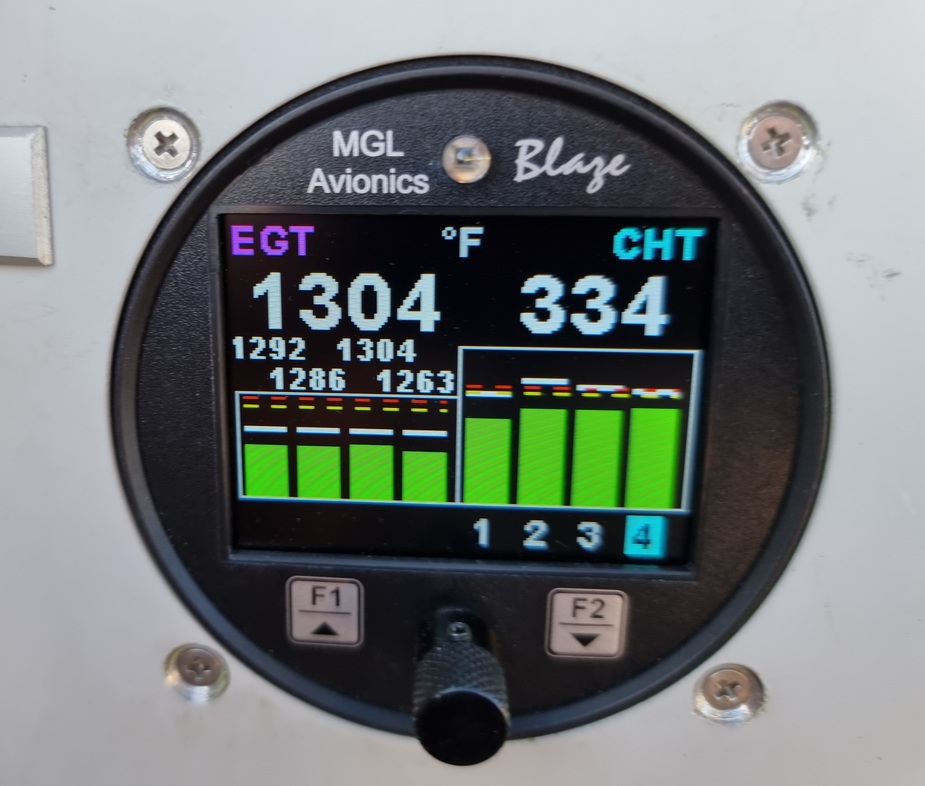Well, it appears to just be a distribution issue related to the throttle butterfly position. Pulling the throttle lever back about half an inch from WOT has little reduction in power but evens out the EGTs nicely:
Regardless of Lycoming recommendations, and depending on CHT, a lot of people sneak back from full throttle enrichment in the climb for this reason, especially given the very high climb rate of an RV.
Once level, you will likely want to be throttled back just slightly (or more), with little effect on MP, to start the leaning process. Then lean it for cruise condition with the mixture lever.
The issue is not of great consequence in terms of fuel consumption on a given point to point flight, although it may be if you were doing circuits. In full throttle climb the carb/manifold is throwing a little extra fuel at the engine for cooling in a fairly haphazard manner.
I think it’s pretty common on an O-320. Ours does the same thing at WOT. I think there’s a John Deakin column that discusses uneven mixture distribution in carburetted engines (and suggests when cruising at high altitude, to back the throttle off slightly, the theory is the change in throttle butterfly position will help with mixture distribution).
I have book that goes into a lot of detail on setting up and tuning Weber and Dell’Orto carburettors on cars.
In initial carburettor setup, one is advised to get the throttle butterflies perfectly parallel to the throats (i.e. throttle as open as can be) and then back them off a very tiny amount before setting the full throttle stop in place. The logic, as someone mentioned above, is that the tiniest bit of throttle introduces turbulence into the flow which continues through the intake tract and promotes the retention of an evenly-distributed mixture.
These are sidedraught carburettors, generally on inline engines, and the length / shape of the intake tract is not necessarily the same for all the cylinders. I had in the past assumed that this ‘turbulent mixing’ was mainly to overcome these inconsistencies, but it is interesting to note that the same appears to apply to an updraught carburettor feeding a four-cylinder horizontally-opposed engine with (presumably) largely identical intake tracts to all four cylinders.
I don’t really understand why, in the OPs case, it gives an inconsistency across cylinders. I would expect a fully-open throttle (totally parallel to throat) to give a slightly uneven mixture to all four cylinders.
This thread shows how little interest (or how little knowledge) there is in “engine management” in carburetted aircraft 
GAMI will sell you a set of injectors for a carb engine. It may be worth writing to GAMI and pointing them to this thread. They are very knowledgeable. I have always flown with GAMIs, but I am injected.
However this may be just a flow peculiarity further back the air path.
Well, it appears to just be a distribution issue related to the throttle butterfly position.
Pulling the throttle lever back about half an inch from WOT has little reduction in power but evens out the EGTs nicely:

I have just completed the service and the oil/filter was clean, so that’s good. Valve lift was consistent throughout the cylinders so I don’t think it’s a worn cam as I originally suspected.
My MA4-5 carb doesn’t have a separate jet for WOT, only the idle jet and the main jet.
Today I should have the chance to test more and then I can see at what throttle setting the EGT split reduces.
I don’t know exact construction for particular engine but in general for full throttle there can be additional jet (or variable size jet) which delivers additional fuel, like on picture below. This can be the cause of different situation of temperature spread on “normal” throttle positions and WOT.

I think GAMI produced a book/ paper on " EGT spread"
it might well explain what you are seeing.
I’ll see if I have a copy amongst all my rubbish but it might be quicker to Google it.
In at least of their articles, one of the engine gurus (Deakin or Bush) mentioned that a partly closed throttle increases turbulence in the intake.
This could/should improve the equal fuel distribution in cases of not ideal intake designs.
(flying an injection engine, I have no own experience)
Sounds like an sample case…
My guess if it’s a carbureted engine would be a fuel distribution issue associated with the extra fuel provided by the carb only when the throttle control is in the fully open position, with the intent of holding down CHT.
You could check this by pulling back on the throttle a bit from fully open, but only until you see fuel flow do a step reduction. Then watch EGT to see if it evens out at that point. As long as CHT stays within limits this won’t hurt anything, so do it starting at moderate CHT and not after an extended climb.